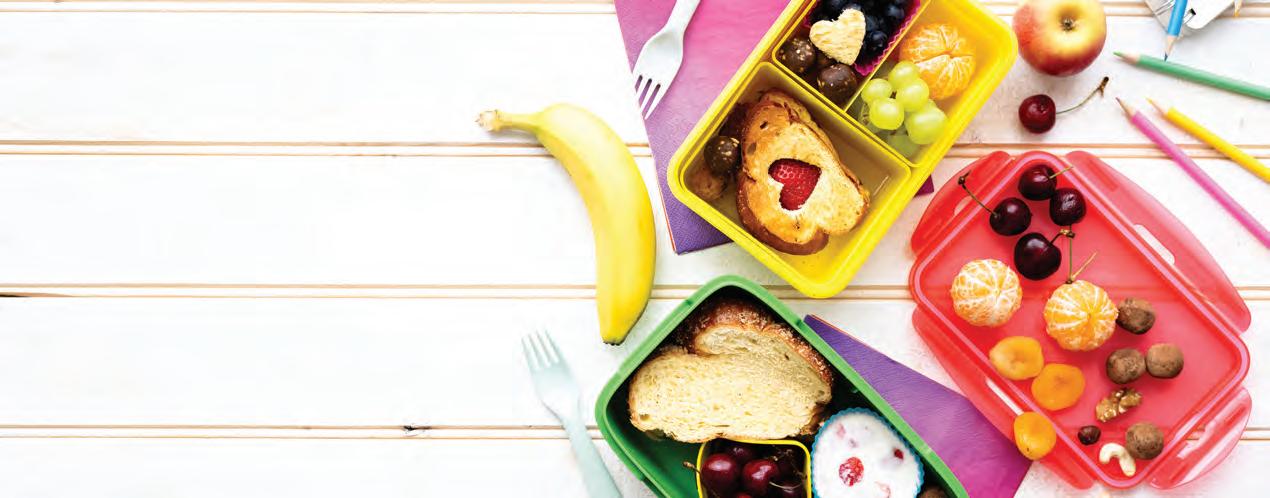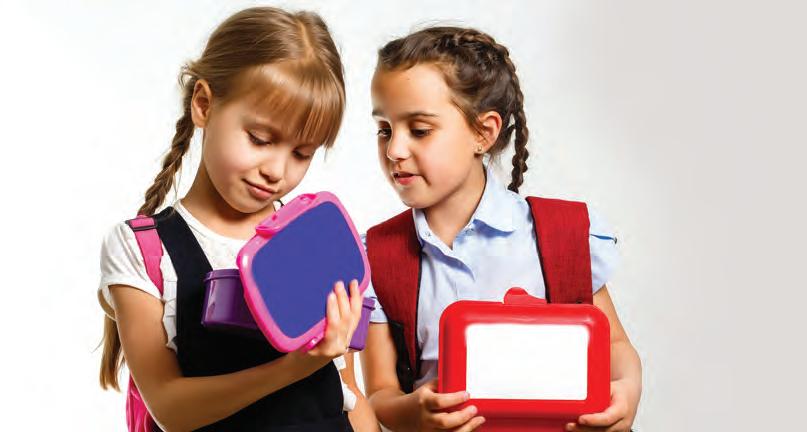
6 minute read
Dietitian’s Six Top Tips to packing a healthier lunch box
Dietitian’s SIX TOP TIPS to packing a healthier
lunch boxBY LAUREN BALE & GINA STEAR
With the new school year well and truly underway, now is the perfect time to think about what you are fuelling your children’s minds and bodies with to tackle their busy school schedules. Children eat 30% of their food while at school so ensuring they enjoy healthy food choices in their lunch boxes is important not only for their learning but also for their growth, development and overall health and wellbeing. Packed lunches don’t have to be boring. With a little thought and imagination, they can be fun, healthy and tasty too. 1 Aim to include something from all 5 food groups Stick to the basics when it comes to deciding what to include in your child’s lunch box. As a rule of thumb, including something from each of the 5 food groups with a drink is a great place to start.
FOOD GROUP WHY IT’S IMPORTANT LUNCH BOX FRIENDLY OPTIONS
GRAINY FOODS E.g. Grainy breads, grains, cereals and starchy vegetables These foods contain carbohydrates that kids use for energy to fuel body movement and brain power. They are also an important source of fibre, necessary for a healthy gut
MEATS & ALTERNATIVES Lean meat, fish, poultry, eggs, nuts and legumes Protein-rich foods important for building strong muscles, bones and teeth
DAIRY & ALTERNATIVES Milk, yoghurt, cheese and/or calcium containing plant-based alternatives
FRUIT
VEGETABLES Protein-rich foods important for building strong muscles, bones and teeth
Rich in vitamins, minerals and fibre, important for glowing skin and hair, eye health, gut health and a strong immune system.
Rich in vitamins, minerals and fibre, important for glowing skin and hair, eye health, gut health and a strong immune system. Wholemeal, wholegrain, sourdough bread, rolls, bagels, pita pockets, wraps and crackers Fruit bread or muffins Basmati or brown rice or fried rice Rice cakes and corn thins Pasta and noodles Roast pumpkin, potato or sweet potato Quinoa and Couscous Nut free Muesli bars
Leftover meat, chicken or fish, roasted chicken or turkey slices, pulled beef or pork Tinned tuna or salmon Hard boiled eggs, Frittata, Hummus Baked beans, chickpeas, kidney beans Veggie burgers and falafel balls Tofu cubes Roasted or baked legume snacks (sugarsnap peas, fava beans & chickpeas)
Drinking yoghurt or yoghurt pot Cheese slices, cubes, sticks Cottage cheese Calcium fortified soya, milk and yoghurt or other plant-based alternatives custard Tetrapack of milk (plain or flavoured)
Seasonal fresh fruit – whole or cut into shapes Fruit salad or Fruit puree Dried fruit (sultanas, mango, apricot, apple)
Raw vegetables (cubes, coins or sticks) Cherry tomatoes Celery, capsicum, cucumber or carrot sticks Corn cob and baby corn spears Popcorn Green beans, snow peas and sugar snap peas Mixed lettuce Leftover cooked vegetables Lentils, chickpeas and kidney beans
Keeping well hydrated is as important as being well nourished. Don’t forget to pack water in a reusable bottle so they can fill it up throughout the day. There’s no need for sweetened drinks such as juice, cordial or soft drink. These tend to contain too much sugar which isn’t good for growing teeth. In summer, it might be helpful to fill a quarter of the bottle with water and freezing overnight. Top up with cold water in the morning to ensure a cool drink for most of the day as well as doubling up as an ice pack for the lunch box.
Try not to over pack While it can be tempting to provide a big range of snacks, fruit, drinks, sandwiches and anything else we can think of into a lunch box (our kids have a long day to get through after all!), sometimes the key is to pack less. An Australian study found that on average children are only eating about 68% of lunch box content, with the lowest consumption rate being for vegetables.
An over packed lunch box can be overwhelming for younger children or those with a smaller appetite.
When choosing what to put in your child’s lunch box, try to think practically about the day ahead. What breaks do they have? Will food be provided at any point? (e.g. at after school care.) Aim to put in just the right amount of food rather than aiming for abundance. Plan a serve of fruit for fruit break, one or two snacks for recess, and something filling for lunch, such as a whole grain sandwich, sushi rolls, leftovers from dinner or mini veggie frittatas. Extras such as an after school snack may be necessary for some children, especially if they head straight from school to other afternoon activities such as sports training.
3 Take time to prepare Meal prep is a great way to stay on track with making healthy food choices, despite busy schedules. Making school lunches a part of your meal plan will help you save time and keep you organised.
Choose a day that you are less busy to wash and chop fruits and vegetables, and prepare batches of healthy proteins like chicken, eggs, and beans. If you don’t have time for this, don’t feel guilty about purchasing pre–chopped and washed fruit and vegetables, pre–cooked chicken, or canned tuna and beans, these are all great options!
Here are a few simple ways to give leftovers from dinner new life in the lunch box: Rice and BBQ chicken can be used to make fried rice with mixed frozen vegetables Pasta can be mixed with tuna, peas, corn and carrots to make a pasta salad Couscous or quinoa with roast vegetables and edamame beans.
Get the kids involved Get your kids involved in planning and helping to pack their lunches for school. Research shows that parents’ involvement of their children in meal planning and preparation is positively related to healthy eating behaviours, increased energy and vegetable intake. So, kids are more likely to enjoy their lunch box food if they are involved in putting it together.
Try some of these simple ways to make them part of the fun: Set some boundaries – set healthy lunch box rules that include choosing a food from each food group Select easy lunch box recipes to cook up on weekends together e.g. banana bread or muffins using ripening bananas. These can be frozen and taken out in the morning before
school Share simple tasks such as cracking eggs, stirring and measuring ingredients Kids love being hands on and visual so think about incorporating variety in taste, shape and colour as you mix ‘n match different options from the different groups together.
Cookie cutter shapes are great for making fruit and sandwiches more interesting. Get your child to fill the drink bottle with water and freeze or refrigerate Your children can help choose the fruit and vegetables when shopping.
5 Trial new foods at home first If you are tired of putting the same old snacks or sandwiches in your child’s lunch box again and again, this could be for you. Children, especially those who have fussier tastes, can feel uncertain or anxious about new or different foods in their lunch box. So, aim to introduce your child to new snacks, sandwich fillings or other options at home first. Once you know your child is comfortable with a new option, they will be much more likely to confidently accept this new food in their lunch box at school.
6 Just make small changes Research from the University of Newcastle has found that small but sustainable changes are effective in helping improve our children’s health over time. So, if you feel that the lunch boxes packed in your home need an overhaul, the trick may actually be in just making small changes, one at a time.
2

4
Lauren Bale and Gina Stear are passionate Paediatric Dietitians at Eatsense, one of the Central Coast’s leading nutrition practices. To book an appointment with an Eatsense dietitian call 4311 3623 or visit





